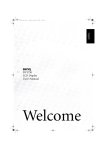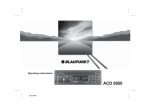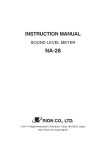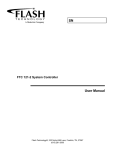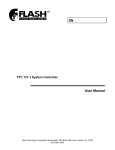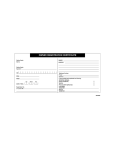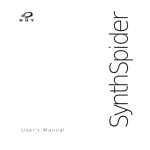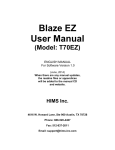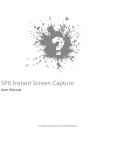Download DV3750 LCD Display User`s Manual
Transcript
DV3750-En.book Page 1 Monday, August 29, 2005 11:38 AM English DV3750 LCD Display User's Manual Welcome DV3750-En.book Page 2 Monday, August 29, 2005 11:38 AM Copyright English Copyright BenQ Corporation. All rights reserved. No part of this User's Manual may be reproduced, transmitted, transcribed, stored in a retrieval system or translated into any language or computer language, in any form or by any means, electronic, mechanical, magnetic, optical, chemical, manual or otherwise, without the prior written permission of BenQ Corporation. is a trademark of SRS Labs, Inc. TruSurround XT technology is incorporated under license from SRS Labs, Inc. Disclaimer BenQ Corporation makes no representations or warranties, either expressed or implied, with respect to the contents of this User's Manual. BenQ Corporation reserves the right to revise this publication and to make changes from time to time in the contents thereof without obligation to notify any person of such revision or changes. Important Safety Instructions Electrical energy can perform many useful functions, but it can also cause personal injury and property damage if improperly handled. This product has been engineered and manufactured with the highest priority on safety, however IMPROPER USE CAN RESULT IN POTENTIAL ELECTRICAL SHOCK OR FIRE HAZARD. In order to prevent potential danger, please observe the following instructions when installing, operating and cleaning the product. Proper care will also prolong the service life of your BenQ display. Just follow these simple instructions before using your display 1. Read instructions - All operating instructions must be read and understood before the product is operated. 2. Retain instructions - These safety and operating instructions must be kept in a safe place for future reference. 3. Observe warnings - All warnings on the product and in the instructions must be observed closely. 4. Follow instructions - All operating instructions must be followe. 5. Water and moisture - Do not use this product near water - for example, near a bathtub, washbowl, kitchen sink, or laundry tub, in a wet basement, or near a swimming pool, and the like. Do not use immediately after moving from a low temperature to a high temperature environment, as this causes condensation, which may result in fire, electric shock, or other hazards. 6. Cleaning - Unplug this product from the wall outlet before cleaning. Do not use liquid cleaners or aerosol cleaners. Use a damp cloth for cleaning. Periodically clean the liquid crystal panel of the display to ensure a clear screen and prolong the service life of the panel. Use a clean, soft and cotton-free dry cloth to dip into the specific cleaner for the liquid crystal panel. Quickly wipe over the whole panel and use another cloth to clean the panel. 7. Ventilation - The vents and other openings in the cabinet are designed to let hot air escape from the display. Do not cover or block these vents and openings since insufficient ventilation can cause overheating and/or shorten the life of the product. Do not place the display on a bed, sofa, rug or other similar surface, since they can block ventilation openings. This display is not designed for built-in installation; do not place the product in an enclosed place such as a bookcase or rack, unless proper ventilation is provided or the manufacturer's instructions are followed. 8. Heat sources - Keep the product away from heat sources such as radiators, heaters, stoves and other heat-generating products (including amplifiers). DV3750-En.book Page 3 Monday, August 29, 2005 11:38 AM 10. Attachments - Do not use attachments not recommended by the manufacturer. Use of improper attachments can result in accidents. 11. Accessories - When the product is used on a trolley, care should be taken to avoid quick stops, excessive force, and uneven surfaces that may cause the product and trolley to overturn, damaging equipment or causing possible injury to the operator. Do not place this product on an unstable trolley, stand, pedestal, bracket, or table. The product may fall, causing serious injury to a child or adult and serious damage to the product. The product should be mounted according to the manufacturer's instructions, and use only with a trolley, stand, pedestal, bracket, or table recommended by the manufacturer. 12. Servicing - Do not attempt to service the product yourself. Removing covers can expose you to high voltage and other dangerous conditions. Request a qualified service person to perform servicing. 13. Replacement parts - In case the product needs replacement parts, make sure that the service person uses replacement parts specified by the manufacturer, or those with the same characteristics and performance as the original parts. Use of unauthorized parts can result in fire, electric shock and/or other danger. 14. Overloading - Do not overload wall outlets, extension cords, or convenience receptacles on other equipment as this can result in a risk of fire or electric shock. 15. Entering of objects and liquids - Never poke an object into the product through vents or openings. High voltage flows in the product, and inserting an object can cause electric shock and/or short circuit internal parts. For the same reason, do not spill water or liquid on the product. 16. Damage requiring service - If any of the following conditions occurs, unplug the power cord from the AC outlet, and request a qualified service person to perform repairs. • When the power cord or plug is damaged. • When a liquid is spilled on the product or when objects have fallen into the product. • When the product has been exposed to rain or water. • When the product does not operate properly as described in the operating instructions. • Do not touch the controls other than those described in the operating instructions. Improper adjustment of controls not described in the instructions can cause damage, which often requires extensive adjustment work by a qualified technician. • If the product has been dropped or the cabinet has been damaged in any way. • When the product displays an abnormal condition or exhibits a distinct change in performance. Any noticeable abnormality in the product indicates that the product needs servicing. 17. Safety checks - Upon completion of service or repair work, request the service technician to perform safety checks to ensure that the product is in proper operating condition. 18. Wall mounting - When mounting the product on a wall, be sure to install the product according to the method recommended by the manufacturer using only the manufacturers mounting hardware. 19. Stand - Do not place the product on an unstable trolley, stand, tripod or table. Placing the product on an unstable base can cause the product to fall, resulting in serious personal injuries as well as damage to the product. 20. Careful move - When relocating the product placed on a trolley, it must be moved with the utmost care. Sudden stops, excessive force and uneven floor surfaces can cause the product to fall from the trolley. 21. Panel protection - The LCD panel used in this product is made of glass. Therefore, it can break when the display is dropped or hit by other objects. Beware of injuries in the event of the LCD glass screen breaking. English 9. Power cord protection - Power-supply cords should be routed so that they are not likely to be walked on or bitten by small animals. Pay particular attention to cords at doors, plugs, receptacles, and the point where they exit from the product. DV3750-En.book Page 4 Monday, August 29, 2005 11:38 AM English 22. Pixel defect - The LCD panel is a high technology product, giving you finely detailed pictures. Occasionally, a few non-active pixels may appear on the screen as a fixed point of blue, green or red. Please note that this does not affect the performance of your product. 23. Installation of an external antenna - If an outside antenna is connected to the television equipment, be sure the antenna system is grounded so as to provide some protection against voltage surges and built-up static charges. For added protection for this television equipment during a lightning storm, or when it is left unattended and unused for long periods of time, unplug it from the wall outlet and disconnect the antenna. This will prevent damage to the equipment due to lightning and power-line surges. An outside antenna system should not be located in the vicinity of overhead power lines or other electric light or power circuits, or where it can collide with such power lines or circuits. When installing an outside antenna system, extreme care should be taken to keep from touching such power lines or circuits, as contact with them might be fatal. Important Information WARNING: TO REDUCE THE RISK OF FIRE OR ELECTRIC SHOCK, DONOT EXPOSE THIS PRODUCT TO RAIN OR MOISTURE. WARNING: FCC Regulations state that any unauthorized changes or modifications to this equipment not expressly approved by the manufacturer could void the user's authority to operate this equipment. (U.S.A. ONLY) CAUTION: TO PREVENT ELECTRIC SHOCK, MATCH WIDE BLADE OF PLUG TO WIDE SLOT, FULLY INSERT. The exclamation point within a triangle is intended to alert the user to the presence of important operating and maintenance (servicing) instructions in the literature accompanying the product The lightning flash with arrowhead symbol within a triangle, alerts the user to the presence of uninsulated "dangerous voltage" within the product's enclosure that may constitute a risk of electric shock. DV3750-En.book Page i Monday, August 29, 2005 11:38 AM Table of Contents English Introduction............................................................................1 Functions and Features ...................................................................................... 1 Package Contents....................................................................2 Getting Started with Your Display.........................................3 Main Unit (Front View)..................................................................................... 3 Control Panel ...................................................................................................... 3 Terminal Panel.................................................................................................... 4 Main Unit (Rear View)....................................................................................... 5 Setting up Your Display .........................................................6 Connecting the Antenna .................................................................................... 6 Connecting CATV...............................................................................................................6 Antenna................................................................................................................................6 Installation of an Outdoor Antenna...................................................................................7 Connecting Audio and Video Signal Sources ................................................... 7 Connecting Composite (AV) Video Signals ......................................................................7 Connecting S-Video Signals................................................................................................8 Connecting Component Video Signals..............................................................................8 Connecting RGB Signals (Mini D-SUB)............................................................................9 Connecting DVI Signals......................................................................................................9 Connecting Audio Output Signals .....................................................................................10 Connecting the Power Cord .............................................................................. 10 Initial Setup......................................................................................................... 11 Remote Control ......................................................................12 Using the Remote Control ................................................................................. 14 Batteries............................................................................................................... 14 Notes on Using Batteries .................................................................................... 14 Using the Remote Control .....................................................15 Power on, Power off and Standby ..................................................................... 15 Turning on the display ........................................................................................................15 Turning off the display........................................................................................................15 Switching Inputs ................................................................................................. 15 Adjusting Volume............................................................................................... 15 Adjusting the volume ..........................................................................................................15 Mute setting .........................................................................................................................15 MTS (TV Sound selection) ................................................................................................15 Changing Channels............................................................................................. 15 Using the Channel selection buttons on the Remote Control to Change Channels .......15 Using the CH / buttons to sequentially change channels .........................................16 Table of Contents i DV3750-En.book Page ii Monday, August 29, 2005 11:38 AM Using the channel button to return to the previous channel. .......................................... 16 English Selecting a Picture Mode .................................................................................... 16 Using the Freeze Function.................................................................................. 16 Adjusting Aspect Ratio ....................................................................................... 16 Using the Picture-in-Picture (PIP)/Picture-by-Picture (PBP) Function ........ 17 Selecting PIP AUDIO ......................................................................................... 17 Selecting Favorite Channels ............................................................................... 17 Selecting TV/CATV Input.................................................................................. 17 Adding/Deleting Sequential Channels............................................................... 17 Using Sleep Timer............................................................................................... 17 Adjusting Backlight............................................................................................. 17 Display Information ........................................................................................... 17 Using the Auto Function .................................................................................... 17 On-Screen Display (OSD) Menu .......................................... 18 OSD Structure..................................................................................................... 18 Navigating the OSD Menu ................................................................................. 19 Audio Menu ........................................................................................................ 19 Picture Menu....................................................................................................... 20 Picture Mode Settings......................................................................................................... 21 Selecting a Picture Mode .................................................................................................... 22 Feature Menu ...................................................................................................... 22 TV Menu ............................................................................................................. 24 Setting up Favorite Channels ............................................................................................. 25 Setting up Closed Caption.................................................................................................. 25 Setting up V-CHIP.............................................................................................................. 25 Movie Ratings ................................................................................................................ 26 TV Ratings ..................................................................................................................... 26 Adjusting V-Chip Setting ................................................................................................... 28 First-Time Setup ........................................................................................................... 28 Adjusting Movie Ratings .............................................................................................. 28 Adjusting TV Ratings .................................................................................................... 28 Canceling the V-CHIP Block Screen While V-CHIP Block is Activated ................... 28 Changing V-CHIP Blocking Password ........................................................................ 28 PC Menu ............................................................................................................. 29 Troubleshooting ..................................................................... 29 TV ........................................................................................................................ 29 Antenna ............................................................................................................... 31 Specifications .......................................................................... 31 Supported Modes ................................................................... 32 Dimensional Drawings........................................................... 32 ii Table of Contents DV3750-En.book Page 1 Monday, August 29, 2005 11:38 AM Introduction Functions and Features The DV3750 has many useful functions and features, including: • 1920 x 1080 image resolution • 550 nits brightness • 800:1 contrast ratio • Compatible with all digital television (DTV) formats, including 1080i, 720P, 576P and 480P • De-Interlacing • Multiple picture modes • Picture In Picture and Picture By Picture display functions • SRS TruSurround XT Home Theater Surround sound experience • Graphic OSD • Shortcut buttons 1. Freeze frame 2. Stereo / MTS television sound 3. Sleep timer 4. Backlight adjustment 5. PC/DVI input signal auto calibration 6. Aspect ratio adjustment 7. Favorite channels Introduction 1 English Thank you for purchasing the BenQ DV3750 LCD Display. Your DV3750 will bring you years of high-quality viewing enjoyment. It is also extremely easy to operate, and provides exceptionally high image quality. The DV3750 is also extremely versatile. You can install it on the wall (optional wall-mounting kit is required) or set it on a table, and it can be used under any type of illumination. This manual will explain the operation of the DV3750, including its functions and features and other important information. Before installing or operating your LCD display, please take the time to thoroughly read this manual, particularly the sections on safety. DV3750-En.book Page 2 Monday, August 29, 2005 11:38 AM Package Contents English Please ensure that the following items are included with your DV3750 LCD Display. If any item is missing or damaged, contact an authorized dealer immediately. DV3750 LCD Display (x1) Power cord (x1) User's manual (x1) Composite (AV) video cable (x1) Remote control (x1) AAA batteries (x2) Actual number and type of cables may vary with the location of purchase. 2 Package Contents DV3750-En.book Page 3 Monday, August 29, 2005 11:38 AM Getting Started with Your Display English Main Unit (Front View) 1 2 No. Name 1 Power indicator 2 Remote control sensor window Description • Lights up green when the display is powered on. • Lights up red when the display is in standby mode. • Flashes red when the display is connected to a PC and the PC enters standby mode. Receives the signal from the remote control. Do not put any objects in front of the window in order not to hinder the reception of signals. Control Panel 5 No. Name 1 Power 4 3 2 1 Description • Press this button to turn the display on when it is in standby mode. • Press this button once more to turn the display off by and put it to standby mode. Getting Started with Your Display 3 DV3750-En.book 2 Page 4 Monday, August 29, 2005 INPUT English 3 Channel / button 4 Volume / button 5 MENU button 11:38 AM • This button allows you to switch among different input signal sources. • When the OSD (On-Screen Display) menu is on, press this button to enter the submenu. • Press these buttons to sequentially select channels. • When the OSD menu is on, press these buttons to move the selection focus up or down or change settings. • Press Volume to increase the volume, or Volume to decrease it. • When the OSD menu is on, press these buttons to move the selection focus left and right or change settings. • Press this button to display the OSD menu. • When the OSD menu is on, press this button to exit the menu. Terminal Panel 1 2 3 4 No. Name 1 AV3 2 Headset socket 3 Subwoofer Getting Started with Your Display Description • VIDEO (Composite (AV) signal input, RCA connector): Connect the Composite video output of your AV device here. • AUDIO(Audio input, L/R): Connect the audio output of your AV device here. This input is used common to both AV and S-VIDEO input. • S-VIDEO (S-VIDEO input): Connect the S-VIDEO output of your AV device here. This socket is for connecting an external headset. Allows you to connect the display to an external subwoofer set for outputting sound. DV3750-En.book Page 5 Monday, August 29, 2005 11:38 AM Main Unit (Rear View) English 11 11 10 9 8 7 6 5 3 2 1 4 No. Name Description 1 AUDIO OUT (L/R) Connect the audio input of an amplifier or here. 2 RS232 This terminal is for service purpose only. • VIDEO (Composite (AV) signal input, RCA connector): Connect the Composite video output of your AV device here. • AUDIO (Audio input, L/R): Connect the audio output of your AV device 3 AV2 here. This input is used common to both AV and S-VIDEO input. • S-VIDEO (S-VIDEO input): Connect the S-VIDEO output of your AV device here. 4 TV/CATV Antenna Connect your antenna to this input. • VIDEO (Composite (AV) signal input, RCA connector): Connect the Composite video output of your AV device here. • AUDIO (Audio input, L/R): Connect the audio output of your AV device 5 AV1 here. This input is used common to both AV and S-VIDEO input. • S-VIDEO (S-VIDEO input): Connect the S-VIDEO output of your AV device here. • Y CB/PB CR/PR (Y CB/PB CR/PR input): Connect the component image output of your AV devices or HDTV decoder here. The Y (green) 6 COMPONENT 2 connector can also be used as a second composite signal input. • AUDIO (Audio input, L/R): Connect the audio output of your AV device here. Getting Started with Your Display 5 DV3750-En.book English 7 8 9 10 11 Page 6 Monday, August 29, 2005 11:38 AM • Y CB/PB CR/PR (Y CB/PB CR/PR input): Connect the component image output of your AV devices or HDTV decoder here. The Y (green) COMPONENT 1 connector can also be used as a second composite signal input. • AUDIO (Audio input, L/R): Connect the audio output of your AV device here. • PC D-SUB (15-pin D-SUB computer signal input): For connecting to PC PC's analog video output. • PC AUDIO: For connecting to PC's audio output. • DVI (Digital Video Input): For connecting to PC's digital video output. DVI • DVI AUDIO (Audio input, L/R): For connecting to DVI's digital audio output. AC INLET Connect the power cord to this input. Speaker connector Connect the external speakers to these connectors. Setting up Your Display Connecting the Antenna Connecting CATV Your DV3750 LCD Display has an internal 75 ohm coaxial cable connector, so antennal hook-up is very easy.When connecting a 75-ohm coaxial cable, secure it firmly to the antenna connector. Some cable TV companies provide "pay per view" programming. Since the signal for these paid channels is encoded, most cable TV companies provide their own tuners/ decoders. You must install a tuner/ decoder to be able to view locked encoded programming. If you require special instructions on how to install cable service, please contact your cable TV provider. The tuner/ decoder provided by your cable TV company can be used according to the following instructions. You must have an RF switch with two inputs (A and B). The "A" input on the RF switch allows you to use the display's CH / buttons to view unlocked channels. The "B" input on the RF switch allows you to use the channel selection button on your cable box to view locked encoded programming via the tuner/decoder. Antenna The antenna equipment has far more effect on reception for color TVs than on black and white models. We suggest you use a good-quality outdoor antenna. Following are simple explanations for the connection of various types of antennas. 1. Generally speaking, 75 ohm systems have a round cable with an F-shaped connector which requires no tools. Attach the cable directly to the input. 2. 300 ohm systems have a flat "dual lead" type cable. A 300-75 ohm transformer may be used to attach the antenna to a 75 ohm input. 6 Setting up Your Display DV3750-En.book Page 7 Monday, August 29, 2005 11:38 AM Installation of an Outdoor Antenna English For best reception it is recommended that an Outdoor antenna be used. A: Use a combination VHF/UHF outdoor antenna. B: Use separate VHF and/or UHF outdoor antennas. Connect the lead from the outdoor antenna to the antenna input on the rear of the display. Connecting Audio and Video Signal Sources • Before connecting any component, please familiarise yourself with the location and type of each input. • If incorrect connections are made, picture or color quality may be adversely affected. Please ensure that all connectors are firmly seated. • Before connecting external devices, turn off the power to the display for safety. Connecting Composite (AV) Video Signals Connect the Composite (AV) output of your AV equipment to the Composite (AV) signal terminal on the display using a Composite (AV) video cable (RCA connector) as illustrated. Composite video input is the most commonly used signal input. However, this type of input also provides a less optimal image quality. Many video sources can only output Composite video signals, for example, VCRs and camcorders. Other video sources, such as laser disc players, actually produce slightly better results when using Composite video. Composite (AV) video cable Video game Setting up Your Display 7 DV3750-En.book Page 8 Monday, August 29, 2005 11:38 AM Connecting S-Video Signals English 1. Connect the S-Video output of your AV equipment to the display's S-VIDEO terminal using an S-Video cable. Pay attention to the direction of the connector on the S-Video cable when inserting. 2. Connect the audio output of your AV equipment to the display's S-VIDEO AUDIO L/R input terminals using the AV cable or equivalent. S-Video cable An S-video signal provides a higher quality image to that of Composite video. It is recommended to use this input whenever possible. If your AV equipment provides a component video output (YPBPR or YCBCR), this should be used in preference to either composite or S-video signals. Audio (AV) cable DVD player Connecting Component Video Signals 1. Connect the Component video output of your AV equipment to the display's COMPONENT Y CB/PB CR/PR terminals using a Component video cable. 2. Connect the audio output of your AV equipment to the display's COMPONENT AUDIO L/R input terminals using the AV cable or equivalent. 1. Of the currently available video signal types, Component video input offers the best quality. Component video output is available on progressive scan DVD players and Digital television decoders. The image quality with this type of input is superior to that obtained with S-video. All High Definition Television signals must go through this input. 2. DV3750 supports 480P, 720P, 576P and 1080i HDTV signals provided by high definition AV equipment such as a HDTV decoder. 3. Ensure the connector colors match, failure to connect the colors of the cables to the corresponding colored terminals will result in a incorrectly color image or badly distorted image. 8 Setting up Your Display Component Video Cable Audio (AV) cable DVD player DV3750-En.book Page 9 Monday, August 29, 2005 11:38 AM Connecting RGB Signals (Mini D-SUB) English 1. Connect the analog video output of your PC to the PC D-SUB terminal on the display using a Mini D-SUB 15-pin cable. 2. Connect the audio output of your PC to the display's PC AUDIO input terminal using an appropriate cable. 1. If the input signal resolution is higher than the default display resolution, the screen may be unable to display image details clearly. 2. You will need a converter to connect a Macintosh computer video to the display using a PC D-SUB 15-pin cable. Audio cable Mini D-SUB cable 3. Certain PC models cannot be connected to the display. 4. The computer in the illustration is shown only for reference; your equipment may vary. 5. Additional equipment shown in the illustration is not provided. 6. Do not set the computer's horizontal and vertical scanning frequencies less than or greater than the frequency range of the display. (refer to "Supported Modes" on page 32) PC 7. If you require more information on how to connect your equipment, please refer to the manual for the piece of equipment you wish to attach. Connecting DVI Signals 1. Connect the digital video output of your PC to the DVI terminal on the display using a DVI-D cable. 2. Connect the audio output of your PC to the display's DVI AUDIO L/R input terminals using the AV cable or equivalent. Audio cable DVI-D cable PC DVD player Setting up Your Display 9 DV3750-En.book Page 10 Monday, August 29, 2005 11:38 AM Connecting Audio Output Signals English DV3750 provides extra audio output terminals for delivering audio signal to an amplifier or other audio devices. Connect the AUDIO OUT L/R terminals on the display to the signal input terminals of an amplifier or other audio devices using the AV cable or equivalent. Audio (AV) cable Connecting the Power Cord 1. Connect the female end of the AC power cord to the AC input on the display. 2. As shown in the diagram, connect the male end to a wall power outlet. Power outlet Power cord • The figure above shows the power cord connection. The shape of the physical power cord plug and socket will differ depending on the location where you purchased the display. • This product must be operated only from the type of power source indicated on the marking label (AC 100-240V, 50-60 Hz). • If the display will not be used for a long period of time, it should be unplugged from the wall outlet. 10 Setting up Your Display DV3750-En.book Page 11 Monday, August 29, 2005 11:38 AM Initial Setup 2. Press the Power button on the display. The display will turn on. The following First Turn On menu will appear. 3. Press the VOL or VOL buttons on the display to select a screen display language, and then press the CH button on the display to go to the next step. 4. Press the VOL or VOL buttons on the display to select the type of TV signal you have connected to the display (TV or CATV). 5. Press the CH button on the display to select Auto Program and then press the INPUT button. The display will start searching for available channels and store them in the memory. This may take several minutes, depending on the available TV channels of your local TV system. 6. Press the MENU button on the display to close the menu. Setting up Your Display 11 English 1. Check to make sure that all connections to your display are correct and firm. DV3750-En.book Page 12 Monday, August 29, 2005 11:38 AM Remote Control English Below is the function description for each button on your remote control. 1. POWER Press this button to power on the display. Press it again to put the display into standby mode. 2. INFO Press this button to display the TV channel message and any other signal messages (including video or computer signals). Press the EXIT button (17) to turn the information off. 3. ASPECT Press this button to adjust screen image aspect ratio. 4. TV/CATV Press this button to switch between TV or cable tuner mode. 5. BACKLIGHT Press this button to select the desired backlight level. 6. PIP/PBP Press this button to simultaneously view signals from two different sources on the screen.You may choose picture-in-picture (PIP) mode or pictureby-picture (PBP) mode. 7. FREEZE Press this button to freeze the screen (the signal will continue to be broadcast). Press the button again to release. 8. SLEEP Press this button to set the automatic shut-off timer. 9. PICTURE Press this button to select a picture mode. 10. PIP AUDIO Press this button to select audio for the sub-picture/ main picture or left/right picture when the display is showing the PIP or PBP screen. 11. CH +/- (add/erase) Press this button to add the current TV channel to the sequential channel selection set. Press this button again to erase the current TV channel from the sequential channel set. 12. "i" button Press this button to let the display automatically adjust frequency, phase and image position in PC or HDTV modes, or search for signal source and properly display the video format in the video mode. 12 Remote Control DV3750-En.book Page 13 Monday, August 29, 2005 11:38 AM 14. INPUT Press this button to select your desired input source. 15. / / / and OK button • : press the or buttons to select settings. • : press the or buttons to adjust OSD menu settings. • Press OK to execute selections, or to enter a submenu you have selected. 16. FAV. (FAVORITE) Press this button to jump to one of the favorite TV channels you have stored. 17. EXIT When operating the on-screen display, press this button to return to the next higher menu level. 18. CH / Press this button to sequencially change channels. 19. VOL +/Press these buttons to raise or lower the volume level. 20. MUTE Press this button to mute the sound output. Press it again to restore the sound output. 21. MTS (TV Sound Selection) Press this button to toggle between stereo and mono sound reception. 22. Direct Channel select Press these buttons to select the channel you wish to view. 23. RECALL Press this button to toggle between the current and the previous channel you were viewing. Remote Control 13 English 13. MENU Press this button to display the OSD (on-screen display) menu for adjusting the image, sound and functions. The function table allows you to use the or buttons to select items. Pressing this button again removes the OSD display. DV3750-En.book Page 14 Monday, August 29, 2005 11:38 AM Using the Remote Control English When using the remote control, aim it at the remote control sensor window on the display. If there is an object between the remote control and the signal remote control sensor window on the display, the remote may not operate. When using the remote control, please note: • Do not strike or drop the remote. Do not expose the remote control to liquids and do not place it in humid environments. • Do not install or place the remote control in direct sunlight. The heat may damage the remote control. • If the remote control sensor window on the display is in direct sunlight or strong light, the remote control may not operate normally. In this situation, change the light source or readjust the angle of your display, or operate the remote control from a location closer to the remote control sensor window on the display. Batteries You will need to install the supplied batteries into the remote control to make it operate following the instructions below. 1. Open the lid of the remote control battery compartment. 2. Insert two size-AAA batteries. Ensure that the batteries are inserted with the positive and negative terminals in the correct direction corresponding to the (+) and (-) marks in the battery compartment. 3. Install the lid of the remote control battery compartment. Notes on Using Batteries The use of the wrong type of batteries may cause chemical leaks and/or explosion. Please note the following: • Always ensure that the batteries are inserted with the positive and negative terminals in the correct direction as shown in the battery compartment. • Different types of batteries have different characteristics. Do not mix different types. • Do not mix old and new batteries. Mixing old and new batteries will shorten battery life and/or cause chemical leaks from the old batteries. • When batteries fail to function, replace them immediately. • Chemicals which leak from batteries may cause skin irritation. If any chemical matter seeps out of the batteries, wipe it up immediately using a dry cloth. • Due to varying storage conditions, the battery life for the batteries included with your display may be shortened. If the remote control is not used for a long period of time, remove the batteries. 14 Remote Control DV3750-En.book Page 15 Monday, August 29, 2005 11:38 AM Using the Remote Control English Power on, Power off and Standby Turning on the display 1. After the power cord is plugged into a wall outlet, the display will turn on and enter standby mode automatically, and the power indicator will light up in red. 2. Press the button on the display, or press the POWER button on the remote control. The display will turn on, and the power indicator will light up in green. 3. The display will automatically search for a signal. If the set is already connected to a signal source, the display will display that signal. Turning off the display Press the button on the display again, or press the POWER button on your remote control again, and the display will go into standby mode. (The power indicator will turn red). Switching Inputs 1.Turn on all connected equipment or computers. 2. Press the INPUT button on your display or press the INPUT button on your remote control to select input signal. 3. Press the button repeatedly until your desired input is displayed. The sequence is as follows: TV -> AV1 ->AV1-S-> AV2 -> AV2-S->AV3->AV3-S->Component 1-> Component 2->PC>DVI->TV... AV1-S, AV2-S or AV3-S will appear only when the S-Video input of AV-1, AV-2 or AV-3 is connected. Adjusting Volume Adjusting the volume 1. Press the VOL button on your display or press the VOL + button on your remote to increase volume. The volume indicator will increase in length as volume rises. 2. Press the VOL button on your display, or press the VOL - button on your remote to decrease volume. The volume indicator will decrease in length as volume falls. Mute setting 1. Press the MUTE button on your remote control to temporarily cut off the sound. 2. Press the MUTE button once more, or press the VOL or Power button on your display or the remote control to restore the sound level. MTS (TV Sound selection) Press the MTS button on your remote control to toggle among "Stereo", "SAP (Second Audio Program)", or "Mono" reception. Changing Channels Using the Channel selection buttons on the Remote Control to Change Channels • To select a single- or double-digit channel, press the corresponding channel selection buttons on the remote control. For example, to select channel 8, press the "0" and "8" channel selection buttons on the remote control. • To select a triple-digit channel, press the button on the remote control followed by the rest of the digits. For example, to select channel 102, press the button, and then press the "0" and "2" buttons on the remote control. Using the Remote Control 15 DV3750-En.book Page 16 Monday, August 29, 2005 Using the CH / 11:38 AM buttons to sequentially change channels English Press the CH or CH button on the remote control, or press CH to sequentially select the TV channels available in your area. or CH on the display Using the channel button to return to the previous channel. To return to the previous viewed channel, press the Channel return remote control. buttonon your Selecting a Picture Mode Depending on the types (contents) of the TV program you are watching, you can select the most appropriate picture mode to make the image more vivid and lively. To change the picture mode, press the PICTURE button on the remote control. This enables you to select from the 6 preset picture modes. You can also set up the picture mode you desire. For more information, refer to the "Picture Mode Settings" on page 21. Using the Freeze Function When watching a TV program, press the FREEZE button on the remote control to freeze the image on the screen (the signal will continue to be broadcast). Press the FREEZE button again to restore normal motion. Adjusting Aspect Ratio Press the ASPECT button on your remote control to select the image aspect ratio you prefer. Press the button several times to cycle through various ratios. 16 • Full Screen - Enlarge the standard 4:3 video signal (e.g. TV signal) to 16:9 full screen video signal. When the original input video source is 16:9 in ratio (e.g. DVD signal), no change will occur. • 4:3 - Display the standard 4:3 video signal (e.g. TV signal) in the center of the screen at the ratio of 4:3. The screen does not change, but black blocks appears in the left and right sides of the screen. When the input video source is 16:9 in ratio, deformation will occur on the screen. • Letterbox -Fill the entire 4:3 screen with a 4:3 video signal. The redundant part on the upper and bottom of the image will be removed and the image will extend vertically and horizontally to fill the full screen. When the input video source is 16:9 in ratio (e.g. DVD signal), no change will occur. • Anamorphic - Fill the entire screen with a 4:3 video signal. Some deformations may be identified on the edge of the image. When the input video source is 16:9 in ratio (e.g. DVD signal), no change will occur. • Real - Display the actual size of the video source without zooming. Using the Remote Control DV3750-En.book Page 17 Monday, August 29, 2005 11:38 AM Using the Picture-in-Picture (PIP)/Picture-by-Picture (PBP) Function • Full Screen: Normal display. • PIP G on V: Enter PIP mode and display graphics on video. • PIP V on G: Enter PIP mode and display video on graphics. • PBP G by V: Enter PBP mode and display graphics by video. • PBP V by G: Enter PBP mode and display video by graphics. V (video)= TV, AV1, AV1-S, AV2, AV2-S, AV3, AV3-S input image. G (Graphics)= Component 1, Component 2, PC or DVI input image. Selecting PIP AUDIO If your display is connected to two different video and audio inputs, pressing the PIP AUDIO button on your remote allows you to select the sound from either the main or sub screen in PIP mode, or from the left or right screen in PBP mode. Selecting Favorite Channels 1. Press the FAV. (FAVORITE) button on your remote control to jump to your preset favorite channelmemory. 2. Press the FAV. (FAVORITE) button again to jump to the next favorite channel memory, and so on. You may select from up to 5 channels to set as your favorites. For more information about how to set up favorite channels, please refer to "Setting up Favorite Channels" on page 25. Selecting TV/CATV Input To select between the TV/CATV systems, press the TV/CATV button on the remote control. Adding/Deleting Sequential Channels The CH+/- button allows you to alter the channels appearing in the Sequential Channel change memory. When Auto Program (see "TV Menu" on page 24) is complete, use the CH+/- button to remove unwanted channels that may have been detected. The CH+/- button can also be used to add additional channels to the sequential channel memory. Using Sleep Timer Press the SLEEP button on your remote control to start setting the automatic sleep timer. Press the SLEEP button several times to adjust the time in increments of 30 minutes, from 0 to 180 minutes. Adjusting Backlight To adjust the intensity of your display's backlight, press the BACKLIGHT button on your remote control to select "Dark" "Normal"or "Bright". Display Information Press the INFO button on your remote control to display the signal information, including input video signal source, Video format, TV sound and current selected channel. Using the Auto Function Press the "i" button on your remote control to have your display automatically adjust the frequency, phase, horizontal and vertical positions in PC and HDTV modes. Using the Remote Control 17 English If your display is connected to an additional Video or PC source, pressing the PIP/PBP button allows you to display both images on the screen at once in PIP (Picture In Picture) or PBP (Picture By Picture) modes: DV3750-En.book Page 18 Monday, August 29, 2005 11:38 AM On-Screen Display (OSD) Menu English OSD Structure 18 On-Screen Display (OSD) Menu DV3750-En.book Page 19 Monday, August 29, 2005 11:38 AM Navigating the OSD Menu • Press the , , or button on the remote control, or the CH , CH , VOL or VOL button on the display to select items on the main menu, choose functions or change settings. • Press the OK button on the remote control, or the INPUT button on the display to enter the submenu. • Press the EXIT button on the remote control to return to the upper layer of menu. • Press the MENU button on the remote control, or the MENU button on your display to exit from the main menu. For more information about the OSD menus, please refer to the following pages: •"Audio Menu" on page 19 •"Picture Menu" on page 20 •"Feature Menu" on page 22 •"TV Menu" on page 24 •"PC Menu" on page 29 Audio Menu 1. Press the MENU button on the remote control or the MENU button on the display to display the main menu. 2. Press the or buttons to select Audio and then press OK to enter the submenu. 3. Press the or buttons to select an item. 4. In the Audio Menu, use the or buttons to adjust the setting or select the options. 5. To return to the menu one level up, press the EXIT button on the remote control, or the MENU button on the display. Item Volume Balance Function Adjust volume level. Adjust left and right volume levels. This option will become unavailable if Audio Out is set to On. Operation Range Use to increase and to decrease 0 to 47 volume. Use to increase right volume, to increase left volume level. -12 to 12 On-Screen Display (OSD) Menu 19 English You can use the OSD menu screen to adjust all the settings on your display. Follow the steps outlined below to select the function you desire, and refer to the pages indicated for more information. Press the MENU button on your remote control, or the MENU button on your display to bring up the following main menu on your screen: DV3750-En.book Page 20 Monday, August 29, 2005 11:38 AM English Select the sound type for Sound Type video inputs (except TV/ CATV input). MTS Select TV/CATV audio. Steady Sound Use the and buttons on the remote control or the VOL and VOL buttons on the display to change selection. Use the and buttons on the remote control or the VOL and VOL buttons on the display to change selection. Automatically adjusts the sound level to be constant amongst different TV staUse the and buttons on the tions when viewing TV pro- remote control or the VOL and grams. VOL buttons on the display to This option will become change selection. • Stereo • Sound 1 • Sound 2 • Stereo • SAP • Mono • Off • Auto unavailable if Audio Out is set to On. Turn on or off SRS TruSurround XT Home Theater Surround Sound Effect. Use the and buttons on the remote control or the VOL and SRS TS VOL buttons on the display to change selection. Use the and buttons on the Select sound output from remote control or the VOL and Audio Out the internal speaker or VOL buttons on the display to external speaker. change selection. Advanced Audio settings- Press OK to enter. • Off • On • Off • On This option will become unavailable if the SRS TS and Audio Out options are set to On. Treble Adjust treble tones Mid Treble Adjust mid-treble tones Middle Adjust mid tones Mid Bass Adjust mid-bass tones Bass Adjust bass tones Use to increase treble tone, to decrease treble tone. Use to increase mid treble tone, to decrease mid treble tone. Use to increase middle tone, to decrease middle tone. Use to increase mid bass tone, to decrease mid bass. Use to increase bass tone, to decrease bass tone. -12 to 12 -12 to 12 -12 to 12 -12 to 12 -12 to 12 Picture Menu 1. Press the MENU button on the remote control or the MENU button on the display to display the main menu. 2. Press the or buttons to select Picture and then press OK to enter the submenu. 3. Press the or buttons to select an item. 4. In the Picture Menu, use the or buttons to adjust the setting or select the options. 5. To return to the menu one level up, press the EXIT button on the remote control, or the MENU button on the display. Item Contrast 20 Function Adjust image contrast. On-Screen Display (OSD) Menu Operation Use to increase contrast, or to reduce it. Range 0 to 32 DV3750-En.book Page 21 Monday, August 29, 2005 11:38 AM Adjust image black level. Adjust the color tint of the Color TEMP. black and white part of the image. To restore a factory preset user customized user Picture Mode or situation mode from memory. ACE (Auto Contrast Enhancement) Adjust the auto contrast enhancement function that optimizes the density of dark and bright areas of images. 0 to 60 English for brighter blacks, for darker blacks. for higher saturation, Color Adjust color saturation. for lower saturation. for redder tones, Tint Adjust color tint. for greener tones. Adjust the sharpness level for a sharper image, Sharpness of the image. for softer image. Advanced Picture Settings - Press OK to enter. Brightness 0 to 64 0 to 30 -14 to 25 • Panel Default: backlight Use the and buttons color on the remote control or • Warm: Biased toward red the VOL and VOL • Normal: Standard video/ buttons on the display to TV color temperature change selection. • Cool: Biased toward blue for PC input • Vivid Use the and buttons • Standard on the remote control or • Movie the VOL and VOL buttons on the display to • Sports • Personal 1 change selection. • Personal 2 Use the and buttons on the remote control or • Off • High the Volume and Volume buttons on the • Middle display to change selec• Low tion. Color Enhancement - Press OK to enter. for more red concentration, for less red concentration. for more green concenGreen Adjust green in image. tration, for less green concentration. for more blue concenBlue Adjust blue in image. tration, for less blue concentration. for more yellow conYellow Adjust yellow in image. centration, for less yellow concentration. Press or buttons to the user situation different user profiles select Save Settings Two preset Personal 1 or Percan be set. sonal 2. Then press OK to save your current settings. Red Adjust red in image. 0 to 30 0 to 30 0 to 30 0 to 30 • To Personal 1 • To Personal 2 Picture Mode Settings 1. Press the MENU button on your remote control or the MENU button on the display to bring up the OSD menu. 2. Press the or button to select Picture and press the OK button to enter the submenu. 3. Select an option (Contrast, Brightness, Color, Tint...) from the Picture menu to adjust your favorite image quality. On-Screen Display (OSD) Menu 21 DV3750-En.book Page 22 Monday, August 29, 2005 11:38 AM 4. Press the or button to select Advanced Picture Settings, and press the OK button to enter the submenu. English 5. Press the or submenu. button to select Save Settings, and press the OK button to enter the 6. Press the or button to save your settings in To Personal 1 or To Personal 2 and then press the OK button to confirm. Selecting a Picture Mode 1. Press the MENU button on your remote control or the MENU button on the display to bring up the OSD menu. 2. Press the or button to select Picture and press the OK button to enter the submenu. 3. Press the or button to select Advanced Picture Settings, and press the OK button to enter the submenu. 4. Press the or picture mode. button to select Picture Mode, and press the or button to select a 5. Press the MENU button to close the menu. You can also press the PICTURE button on the remote control to switch to the picture mode you want directly. Feature Menu 1. Press the MENU button on the remote control or the MENU button on the display to bring up the main menu. 2. Press the or buttons to select Feature and then press OK to enter the submenu. 3. Press the or buttons to select an item. 4. In the Feature Menu, use the or buttons to adjust the setting or select the options. 5. To return to the menu one level up, press the EXIT button on the remote control, or the MENU button on the display. Item Function Operation Select which audio Use the and buttons source you want to hear. on the remote control or PIP Audio This option is avail- the VOL and VOL buttons on the display to able only if the PIP mode is activated. change selection. Select which audio Use the and buttons source you want to hear. on the remote control or PBP Audio This option is avail- the VOL and VOL buttons on the display to able only if the PBP mode is activated. change selection. Display video and Use the and buttons images simultaneously on the remote control or PIP & PBP* in either Picture-In-Pic- the VOL and VOL ture or Picture-By-Pic- buttons on the display to ture mode. change selection. 22 On-Screen Display (OSD) Menu Range • Main • Sub • Left • Right • Full screen • Graphics On Video • Video On Graphics • Graphics By Video • Video By Graphics DV3750-En.book Page 23 Monday, August 29, 2005 11:38 AM Aspect Ratio Adjust image aspect ratio. • No • Yes English Use the and buttons Freeze motion of screen on the remote control or Freeze image (however, broad- the VOL and VOL cast continues). buttons on the display to change selection. Use the and buttons Adjust backlight inten- on the remote control or Backlight the VOL and VOL sity. buttons on the display to change selection. Use the and buttons Set the Sleep timer to on the remote control or Sleep Timer automatically turn off the VOL and VOL the display. buttons on the display to change selection. Advanced Feature- Press OK to enter. • Dark • Normal • Bright 0, 30, 60, 90, 120, 150, 180 minutes • Full Screen - Enlarge the standard 4:3 video signal (e.g. TV signal) to 16:9 full screen video signal. When the original input video source is 16:9 in ratio (e.g. DVD signal), no change will occur. • 4:3 Format - Display the standard 4:3 video signal (e.g. TV signal) in the center of the screen at the ratio of 4:3. The screen does not change, but black blocks appears in the left and right sides of the screen. When the input video source is 16:9 in ratio, deformation will Use the and buttons occur on the screen. on the remote control or • Letterbox -Fill the entire 4:3 the VOL and VOL screen with a 4:3 video signal. buttons on the display to The redundant part on the change selection. upper and bottom of the image will be removed and the image will extend vertically and horizontally to fill the full screen. When the input video source is 16:9 in ratio (e.g. DVD signal), no change will occur. • Anamorphic - Fill the entire screen with a 4:3 video signal. Some deformations may be identified on the edge of the image. When the input video source is 16:9 in ratio (e.g. DVD signal), no change will occur. • Real - Display the actual size of the video source without zooming. On-Screen Display (OSD) Menu 23 DV3750-En.book Page 24 Monday, August 29, 2005 11:38 AM TV, AV1, AV1-S, AV2, AV2-S, Use the and buttons AV3, AV3-S Select video signal input on the remote control or source for PIP/PBP the VOL and VOL AV1-S, AV2-S or AV3-S will appear only when the S-Video function. buttons on the display to input of AV-1, AV-2 or AV-3 is change selection. English Video Input connected. graphics signal Graphics Select input source for PIP/ Input PBP function. Reset All Restore all settings to Settings default values. Use the and buttons on the remote control or the VOL and VOL buttons on the display to change selection. Press the OK button on the remote control or the INPUT button on the display to reset. • PC • Component 1 • Component 2 • DVI PIP/PBP Functions are available with 480P, 576P, 720P and 1080i HDTV formats. TV Menu 1. Press the MENU button on the remote control or the MENU button on the display to bring up the main menu. 2. Press the or buttons to select TV and then press OK to enter the submenu. 3. Press the or buttons to select an item. 4. In the TV Menu, use the or buttons to adjust the setting or select the options. 5. To return to the menu one level up, press the EXIT button on the remote control, or the MENU button on the display. Item Language TV/CATV Channel +/Closed Caption Favorite Channels 24 Operation Range Use the and buttons on • English remote control or the Select language for the the VOL and VOL buttons • Français OSD menu. on the display to change selec- • Español • 繁體中文 tion. Use the and buttons on the remote control or the Select TV or cable VOL and VOL buttons • TV system mode. on the display to change selec- • CATV tion. Use the and buttons on Add weak or addithe remote control or the tional channels or delete unwanted VOL and VOL buttons • Skipped channels from TV on the display to change selec- • Added memory. tion. (See "Setting up Closed Caption" on page 25) Set and change Refer to "Setting up Favorite Favorite 1, 2, 3, 4, 5 Favorite Channels Channels" below. On-Screen Display (OSD) Menu Function DV3750-En.book Page 25 Monday, August 29, 2005 11:38 AM English Tuner will search through all available Press the OK button to start Auto Program channels and add channel search. them to memory. V-CHIP Block Settings (See "Setting up V-CHIP" on page 25) Setting up Favorite Channels 1. Press the MENU button on the remote control or the MENU button on the display to bring up the main menu. 2. Press the or 3. Press the or submenu. buttons to select TV and then press OK to enter the submenu. buttons to select Favorite Channels and then press OK to enter the 4.Press the or buttons to set your favorite channels (Favorite 1, Favorite 2, .... Favorite 5), then press the channel selection button on your remote control to enter the channel number that you desire. 5. Press the EXIT button on the remote control. Setting up Closed Caption Closed Caption is a system which allows conversations, narration, and sound effects in TV programs and home videos to be viewed as captions on the TV screen. Not all the programs and videos will offer closed captioning. Please look for the symbol to ensure that captions will be shown. 1. Press the MENU button on the remote control or the MENU button on the TV to bring up the main menu. 2. Press the or button to select TV and then press OK to enter the submenu. 3. Press the or button to select Closed Caption. 4. Press the or button on the remote control or the VOL or VOL display to choose among the available choices for the selected option. button on the • Closed Caption may malfunction (white blocks, strange characters, etc.) if signal conditions are poor or if there are problems at the broadcast source. This does not necessarily indicate a problem with your display. • If no TEXT broadcast is being received while viewing in the [TEXT] mode, the screen may become dark and blank for some programs. Should this occur, switch the Closed Caption mode to OFF. • Close caption will disappear temporarily when the OSD menu is displayed on the screen. Setting up V-CHIP This function allows TV programs to be restricted and TV usage to be controlled based on FCC data. It prevents children from watching violent or sexual scenes that may be harmful. Restriction of TV programs includes two ratings that contain information about the program: the Movie Ratings and the TV Ratings. The Movie Ratings are restricted by age. TV Ratings are restricted by age and content. Since a TV program may use either the Movie Rratings or the TV Ratings, both should be adjusted for complete control. On-Screen Display (OSD) Menu 25 DV3750-En.book Page 26 Monday, August 29, 2005 11:38 AM Movie Ratings English Ratings G GENERAL AUDIENCES. All ages admitted. GUIDANCE SUGGESTED. Some material may not be suitable PG PARENTAL for children. STRONGLY CAUTIONED. Some material may be PG-13 PARENTAL inappropriate for children under 13. R RESTRICTED. Under 17 requires accompanying parent or adult guardian. NC-17 NO ONE 17 AND UNDER ADMITTED. is an older rating that is unified with NC-17 but may be encoded in the X X data of older movies. Age Base Movie Ratings (examples) Example 1 PG-13 in the age-based rating is blocked, this will also automatically block the higher ratings R, NC-17 and X. Example 2 R in the age-based rating is blocked, this will also automatically block the higher ratings NC-17 and X. The Movie Ratings are only age-based. TV Ratings Canadian English TV Ratings Rating Age Base 26 Content base Exempt programming includes: news, sports, documentaries Exempt (No and other information programming; talk shows, music videos, blocking)) and variety programming. Programming intended for children with this designation must adhere to the provisions of the Children's section of the C (Children) Canadian Association of Broadcasters (CAB) Voluntary Code on Violence in TV Programming. This classification is applied to children's programming that is C8+ (Children, generally considered acceptable for youngsters 8 years and over eight years and to view on their own. It is suggested that a parent/guardian coview programming assigned this classification with younger older) children under the age of 8. This is programming intended for a broad, general audience. G (General While not designed specifically for children, it is understood that Programming, younger viewers may be part of the audience. Therefore suitable for all ages) programming within this classification shall contain very little violence, either physical, verbal or emotional. This programming, while intended for a general audience, may be suitable for younger children (under the age of 8). PG (Parental Guid- not Parents/guardians should be aware that there might be content ance) elements which some could consider inappropriate for unsupervised viewing by children in the 8-13 age range. Programming with this classification contains themes or content elements which might not be suitable for viewers under the age of 14. Parents are strongly cautioned to exercise discretion in 14+ (Viewers 14 permitting viewing by pre-teens and early teens without parent/ years and older) guardian supervision, as programming with this classification could deal with mature themes and societal issues in a realistic fashion. On-Screen Display (OSD) Menu DV3750-En.book Page 27 Monday, August 29, 2005 11:38 AM This classification applies to programming which could contain any or all of the following content elements which would make the program unsuitable for viewers under the age of 18. Canadian French TV Ratings Rating Age Base Content base Parmi les émissions exclues figurent celles-ci : nouvelles, Exempt (Aucun sports, documentaires et autres émissions d'information, talkblocage) shows, vidéoclips et émissions de variété. Cette émission convient à un public de tous âges. Elle ne contient aucuneviolence ou la violence qu'elle contient est G (Général) minime, ou bien traitée sur le mode de l'humour, de la caricature, ou de manière irréaliste. Cette émission convient à un public large mais elle contient 8 ans+ (Généralune violence légère ou occasionnelle qui pourrait troubler de Déconseillé aux jeunes enfants. L'écoute en compagnie d'un adulte est donc jeunes enfants ) recommandée pour les jeunes enfants (âgés de moins de 8 ans) qui ne font pas la différence entre le réel et l'imaginaire. 13 ans + (Cette Elle contient soit quelques scènes de violence, soit une ou des émission peut ne pas scènes d'uneviolence assez marquée pour les affecter. L'écoute convenir aux enfants en compagnie d'un adulte est donc fortement recommandée de moins de 13 ans) pour les enfants de moins de 13 ans. 16 ans + (Cette émission ne convient Elle contient de fréquentes scènes de violence ou des scènes pas aux moins de 16 d'une violenceintense. ans) 18 ans + (Cette contient une violence soutenue ou des scènes d'une émission est réservée Elle violence extrême. aux adultes) USA TV Ratings Rating Content Base Exempt programming includes: news, sports, documentaries None (No blocking)) and other information programming; talk shows, music videos, and variety programming. TV-Y (All children) The program is designed to be appropriate for all children. The program is designed for children age 7 and above.It may TV-Y7 (Direct to be more appropriate for children who have acquired the developmental skills needed to distinguish between makeOlder Children) believe and reality. Most parents would find The program suitable for all ages. TV-G (General Although this rating does not signify a program designed Age specifically for children, most parents may let younger Audience) children watch this program unattended. Base The program contains material that parents may find TV-PG (Parental for younger children. Many parents may want to Guidance Suggested) unsuitable watch it with their younger children. The program contains some material that many parents would find unsuitable for children under 14 years of age. TV-14 (Parents are strongly urged to exercise greater care in Strongly Cautioned) Parents monitoring this program and are cautioned against letting children under the age of 14 watch unattended. TV-MA (Mature The program is specifically designed to be viewed by adults and therefore may be unsuitable for children under 17. Audience Only) V , FV Programs with violence or fantasy violence contents. Programs that contain strong language Content L Base S Programs with sexual situations. D Programs with suggestive dialogs. On-Screen Display (OSD) Menu 27 English 18+ (Adult Programming) DV3750-En.book Page 28 Monday, August 29, 2005 11:38 AM Example English When the V (FV) content based rating in the TV-Y7 age-based rating is set to BLOCK, this will automatically block the V (FV) contents in higher ratings: TV-G, TV-PG, TV-14 and TV-MA. Choosing a lower age-based rating blocks the higher age-based ratings regardless of content based rating settings. Adjusting V-Chip Setting First-Time Setup 1. Press the MENU button on the remote control or the MENU button on the display to bring up the main menu. 2. Press the or buttons to select TV and then press OK to enter the submenu. 3. Press the or buttons to select V-CHIP Block Settings and then press OK to enter the submenu. 4. Enter a 4-digit password (the factory-preset password is 0000). 5. Press the or buttons to select Enter V-CHIP Blocking Settings, and then press the OK button. Adjusting Movie Ratings 1. Press the or buttons to select Movie Ratings. 2. Use the or buttons to select a rating. Adjusting TV Ratings Adjusting Canadian English and Canadian French TV Ratings 1. Press the or buttons to select Canadian English TV Ratings or Canadian French TV Ratings. 2. Use the or buttons to select a rating. Adjusting USA TV Ratings 1. After the password is entered, press the press the OK button. 2. Use the or or buttons to select USA TV Ratings and then buttons to select an age-based rating. 3. Press the or buttons to select a content based rating, and then press the to select Block or Show. or buttons Canceling the V-CHIP Block Screen While V-CHIP Block is Activated 1. "The program is blocked" will appear on the screen if you watch a program that matches the rating data you configured. 2. Enter the 4-digit password by using the channel selection buttons.V-CHIP Block will be temporarily canceled. If an incorrect password is entered, it cannot be unblocked. Changing V-CHIP Blocking Password 1. Press the MENU button on the remote or the MENU button on the display to bring up the main menu. 2. Press the or buttons to select TV and then press the OK button to enter the submenu. 3. Press the or buttons to select V-CHIP Block Settings and then press the OK button to enter the submenu. 4. Press the or buttons to select Change Password, and then press the OK button. 5. Enter the new password. 6. You will be prompted to enter the new password again. Now you have successfully changed the V-CHIP Blocking password. 28 On-Screen Display (OSD) Menu DV3750-En.book Page 29 Monday, August 29, 2005 11:38 AM PC Menu 1. Press the MENU button on the remote control or the MENU button on the display to bring up the main menu. 2. Press the or buttons to select PC and then press OK to enter the submenu. 3. Press the or buttons to select an item. 4. In the PC Menu, use the or buttons to adjust the setting or select the options. 5. To return to the menu one level up, press the EXIT button on the remote control, or the MENU button on the display. Item Function DPMS Protect screen and enter power saver mode when no PC signal is detected. Frequency Adjust display clock frequency. Operation Range Use the and buttons on the remote control or the VOL and • Off VOL buttons on the display to • On change selection. Use the and buttons on the remote control or the VOL and -32 to 32 VOL buttons on the display to change selection. Adjust display clock phase. When receiving Component video signal in 480P, 576P, 720P or 1080i format, you can use this function to enhance the sharpness of the picture. Phase H. Position V. Position Auto Use the and buttons on the remote control or the VOL and 0 to 31 VOL buttons on the display to change selection. Use the and buttons on the Adjust horizontal position of remote control or the VOL and -30 to 30 the image. VOL buttons on the display to change selection. Use the and buttons on the Adjust vertical position of the remote control or the VOL and -30 to 30 image. VOL buttons on the display to change selection. Automatically adjusts freUse the OK button on the remote quency, phase, H. position control or the INPUT button on and V. position to place the the display to begin auto adjustimage on the screen. ment. Troubleshooting Before calling a service center, attempt the following steps to diagnose the problem. TV Symptoms Power does not turn ON Possible Causes Ensure the power plug is securely inserted into the receptacle and wall socket. Troubleshooting 29 English Options in this menu are available only if you have connected PC or DVI signals to the display. DV3750-En.book Page 30 Monday, August 29, 2005 11:38 AM English • Ensure the display power is ON (Indicated by the green Power indicator on the front of the display) • Try a different input source to check whether the source is at There is no picture or sound fault. • Check for mis-connection of cables or for wrong input source. Your display is being affected by interference from automobiles, trains, high-voltage transmission lines, neon signs or There are spots on the screen another sources of interference. Try redirecting or relocating your antenna to reduce the affects of the interference. • Check whether all the picture adjustments have been properly performed. Degraded colors or tints • Press the PICTURE button on the remote control to select a different picture mode. Try selecting a different aspect ratio by pressing the ASPECT Improper screen position or size button on the remote control. Ensure the display's aspect ratio is correctly set to suit the The image appears distorted program source. The image appears too bright, • Reduce the contrast setting. and there is a loss of definition • The DVD player is set for a high-level output. in the brightest areas of the • The AV video signal has not been terminated properly image. somewhere in the external AV equipment. The image appears too 'washed • Reduce the brightness level till the black areas of the picture out', or the darkest areas of the appear as black. image appear too bright. • The DVD player may be set at too high a brightness level. • Check the PC/DVI cable for disconnection. Power indicator lamp flashes • This indicates the PC/DVI input has been selected with no red. PC/DVI source signal. • The PC has been put to Standby mode. "Out of range" appears • Check whether the input signal is acceptable to the display. • Check for incorrect battery orientation. • Check for dead batteries • Check your distance and angle from the display. • Check whether remote control is properly being pointed at the display's remote control sensor window. • Check for any obstacle between the remote control and the Remote control does not func- remote control sensor window. tion properly • Check that the remote control sensor window is not under strong fluorescent lighting. • Check for any devices (PC or personal digital assistant, PDA) nearby that transmit infrared signal which may cause interference to signal transmission between the remote control and the LCD display. Turn off the infrared function of these devices. There is no picture or sound, • Make sure the antenna cable is properly connected. just noise. • Change channels to confirm if the symptom is still present. • Make sure the antenna cable is properly connected. • Change channels to confirm if the symptom is still present. Picture is not clear. • If PC is selected as the input signal source, use the Auto function in the PC Menu to let the display adjust picture automatically. • Check whether you have selected the Mute function. No sound. • Make sure the volume is not set to minimum. • Check the AV cables for disconnection. 30 Troubleshooting DV3750-EN.fm Page 31 Monday, August 29, 2005 6:10 PM Antenna Possible Causes • The reception may be weak. The picture is not sharp or the • Change channels to confirm if the symptom is still present. picture moves contains image • Make sure the outside antenna is not disconnected. movement. • Make sure the antenna is facing the right direction. • Make sure the antenna is facing the right direction. • Picture ghosting is caused by reflections from buildings, The picture is doubled or tripled. large metal structures and mountains. Carefully realign your antenna to minimise the ghost images. Ultimately a higher quality antenna professionally installed may be necessary to reduce the ghosting. • There may be interference from automobiles, trains, high voltage lines, neon lights, etc. The picture is spotted. • There may be interference between the antenna cable and power cable. Try positioning them further apart. • Is the television receiving interference from other devices? Transmission antennas of radio broadcasting stations and There are stripes on the screen or transmission antennas of amateur radios and cellular phones may also cause interference. colours fade. • Use the television as far away as possible from devices that may cause possible interference. Specifications Model Size Aspect ratio Resolution Pitch Brightness Contrast ratio Viewing angle Response time Amplifier TV Video Signal inputs PC Signal outputs Scan format DV3750 94 cm (37 inches) 16:9 1920 x 1080 0.42675 x 0.42675 (mm) 550 nits 800:1 176º/176º 8 ms (Gray to Gray) 15W x 2 TV tuner S-Video Composite video (RCA) Component video (Y PB PR) Audio input DVI PC D-sub DVI audio input PC audio Audio output Headphone output Subwoofer output 480P/576P/720P/1080i Specifications 31 English Symptoms DV3750-En.book Page 32 Monday, August 29, 2005 11:38 AM English PC horizontal frequency PC vertical frequency Power supply Operating temperature Storage temperature Operating humidity 31.5 ~ 60 kHz 50 ~ 70 Hz AC 100-240 V, 50-60 Hz 0 ° C ~40 ° C (at sea level) -20 ° C ~ 50 ° C (at sea level) 20% ~ 90% Design and specifications are subject to change without notice. Supported Modes Resolution 720 × 400 640 × 480 640 × 480 640 × 480 800 × 600 800 × 600 1024 × 768 Horizontal Freq. (khz) Vertical Freq. (Hz) Bandwidth (Mhz) 31.47 70.08 28.32 31.47 60.00 25.18 37.50 75.00 31.50 37.86 72.80 31.50 37.88 60.32 40.00 46.86 75.00 49.50 48.36 60.00 65.00 Notes DOS mode DOS mode VESA VESA VESA VESA VESA Optimal settings for this product are as listed above. It is suggested that you select appropriate settings from this table to obtain optimal performance. Dimensional Drawings Unit: mm 32 Supported Modes






































